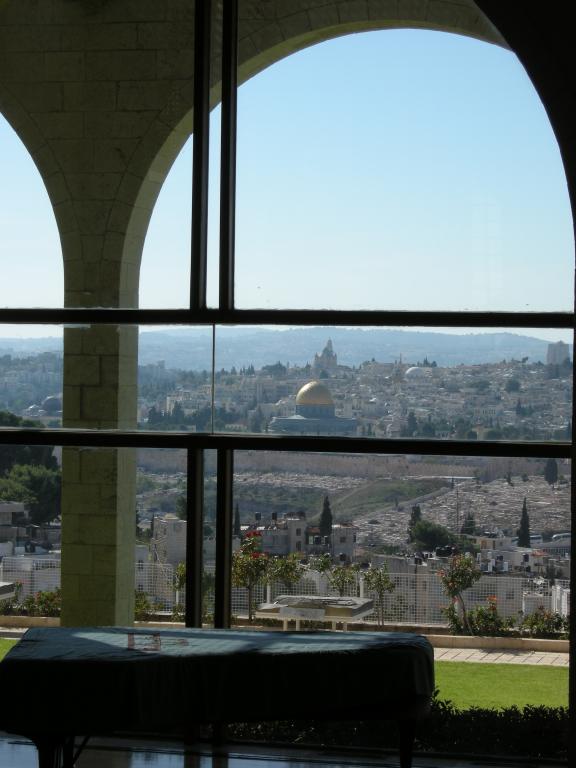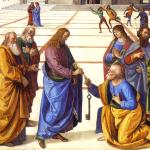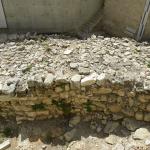
(Wikimedia Commons public domain photograph)
Thursday was our first actual day of touring with our group. (We met them in the airport at Lod on Wednesday night, and brought them up to Jerusalem from there.)
First, we took them to the City of David, to the area known as “the ophel.” Excavations and tourist-friendly development have changed it very much since I first saw it, roughly back under the reign of Solomon. Then they went through Hezekiah’s Tunnel, the so-called “wet tunnel,” while my wife and I chose instead to go through the relatively newly-discovered “dry tunnel,” which is both considerably shorter and considerably older. (It was created by the Canaanites who preceded the Israelite occupation of Jerusalem.). We both came out by the biblical Pool of Siloam, in the modern Arab village of Silwan. Thereafter, we took them up onto the Temple Mount, where I was in sheer bliss while talking about such things as the history of the Temple of Jerusalem, the Dome of the Rock, Al-Aqsa Mosque, Muhammad, his miraculous “night journey,” and etc. and etc. Then we visited the “Western Wall” — commonly but now unfashionably known in past years as the “Wailing Wall” — and climbed up onto the “teaching steps” at the southern end of the Temple site. These are first-century steps that provided the main ancient entrance into the Temple precincts; Jesus and his apostles almost certainly walked on them.
Because of a marathon on Friday morning, all of the streets around our hotel were closed off. So we had to walk over to Damascus Gate in order to catch our bus. And you really notice how hilly Jerusalem is — located as it is on a mountain ridge — when you walk. I always chuckle when we sing the Latter-day Saint Christmas carol “Far, Far Away on Judea’s Plains” during the holiday season: I like the song a lot, but John Menzies Macfarlane had plainly never visited the Holy Land.
Once we had our bus, we took our little group down the highway past Bethany toward Jericho and the Dead Sea, turning left at “Genesis Land” for a camel ride. Then, switching plans not only because of the marathon but in view of multi-day weather forecasts, we traveled to Bethlehem. The first checkpoint at which we arrived was unexpectedly closed — such things happen under sometimes arbitrary military occupation — so we had to travel a fair distance around to an alternative passageway through the Israeli “security wall” in Bethlehem. Once we were in town, we took them to the Nissan Brothers olivewood factory and shop and then to the emperor Justinian’s ancient Church of the Nativity. From there we headed off to lunch, but we didn’t eat, as we always have before, in The Tent Restaurant overlooking the traditional Shepherds’ Fields. Since our visit today was unexpected, we weren’t expected there. Instead, we ate at another restaurant nearby, which had pretty much the same food but, alas, without quite the same flavor. Then we went to the Franciscans’ Shepherds’ Fields location, as we always do. Finally, we visited the Church of Saint Peter in Gallicantu, not far from Zion’s Gate in the Old City Wall. This is the traditional site where Jesus appeared for his initial judgment before the high priest Caiaphas and where Peter is said to have denied Christ. If it is the proper location, then the first-century steps that come up to it from the Kidron Valley become quite important: They would almost certainly have been the way by which Jesus, after his arrest in the Garden of Gethsemane, was brought up to stand before Caiaphas.
We started off the morning today (Saturday) with a visit to the Church of All Nations and the adjacent Garden of Gethsemane and then to the Orson Hyde Gardens just above. It’s a wonderful place, obviously, to talk about the atonement of Christ, which is what we did. The place was awash with Latter-day Saints — three busloads from Bountiful Travel alone — and it was fun to run into John Bytheway, Kevin Hinckley, and Dave Hadlock. Then we attended sacrament services — branch conference, as it happened — at Brigham Young University’s Jerusalem Center for Near Eastern Studies, where it was a pleasure to spend some time visiting with, among others, David Rolph Seely. , the author of, among many other things, Solomon’s Temple: Myth and History, with our late mutual friend Bill Hamblin. As we commonly do, we reminisced about Bill, whom we both miss very badly.
Afterwards, we drove out to the Israel Museum, where we spent some helpful time with the huge outdoor model of Jerusalem in the late Second Temple Period. It’s a wonderful teaching tool, and it helps to make sense of the topography and geography of what our group has been seeing for the past few days. I certainly wish that we had a model like this one back in Utah! We then had a look at the Shrine of the Book, where the large majority of the Dead Sea Scrolls are housed. From there, I led our little band up to the archaeological section of the museum and directly to three of my favorite objects in its collection: 1) the Pilate inscription from Caesarea Maritima, 2) the ossuary or bone box of the high priest Caiaphas, and 3) a replica of the heel bone of Jehohanan, son of Hagkol, which illustrates the technique of first-century Roman crucifixion.
Finally, we visited the Church of St. Anne (a Crusader structure dedicated to the mother of the Virgin Mary, who, tradition says, grew up on the site) and the directly adjacent Pools of Bethesda. (The Church later became a religious school under the great counter-crusader Saladin — Sultan Salah al-Din, something of a hero of mine — whose commemorative plaque is still plainly visible above the church’s main door.) From there, we walked up the Via Dolorosa, taking time to explore remnants of the Antonia Fortress that Herod built and that served as the Roman military headquarters in the city. (Many think that Christ’s trial before Pontius Pilate took place in the Antonia.) Our walk along the traditional Via Dolorosa culminated, as it was supposed to do, in the Church of the Holy Sepulcher, which encloses the traditional locations of the crucifixion, burial, and resurrection of the Savior. It’s is another of my favorite places to introduce to my groups, and I was relieved to see that the famous Immovable Ladder is still in place — after only three centuries or so, it might just disappear any day now!
It’s been a little difficult to keep my energy up. This is the third — maybe the fourth — visit here in a row where I’ve come down with some illness or other. This time, it’s both a respiratory issue and, for the past couple of days, an upset stomach. No rest for the wicked, I guess.
Posted from Jerusalem, Israel











